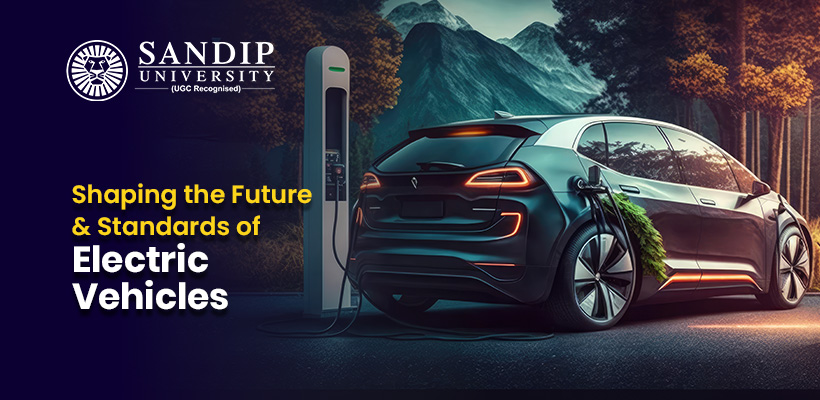The area of mechanical engineering is vital for determining how transportation will develop in the future as people embrace sustainability and look for alternatives to conventional fossil fuel-powered cars. Leading this transformation are electric vehicles (EVs), which provide a more effective and environmentally friendly form of mobility. Many top engineering colleges in Maharashtra offer M.Tech in Electric Vehicles to contribute towards the growth of the automobile industry by providing them with competent professionals.
This blog will examine the contributions made by mechanical engineers to the creation and development of electric cars emphasising significant advancements and emerging trends.
Latest Trends in Electrical Vehicles
The Technology of Batteries
An electric vehicle’s battery is one of its most important parts. To increase energy density, charging speed, and overall lifespan of batteries, mechanical engineers are always trying to improve their technology. The creation of more robust and efficient batteries for EVs is made possible by the use of solid-state electrolytes and silicon anodes.
Furthermore, in order to save weight and space, mechanical engineers are investigating novel battery designs including conformable and flexible batteries that can be included into the vehicle’s construction. These developments are essential to lowering the cost, increasing dependability, and improving the use of electric vehicles for daily use.
Powertrains and Electric Motors
Another area where mechanical engineering is essential to the development of electric cars is in electric motors. Engineers are always looking for ways to increase torque output, heat management, and motor efficiency. For instance, permanent magnet motors are perfect for electric vehicles because they have greater power density and efficiency than conventional induction motors. Additionally, developments in electricity. EV powertrains are becoming more dependable and efficient thanks to electronics and control systems. To improve electric car performance and range, mechanical engineers are creating powertrains that maximise energy conversion and distribution.
Design and Materials That Are Lightweight
Mechanical engineers are concentrating on employing lightweight materials and aerodynamic design to increase the efficiency and range of electric vehicles. High-strength steel, aluminium alloys, and advanced composites are being used to lighten EVs without sacrificing performance or safety.
Aerodynamic design is also essential for lowering drag and raising the overall efficiency of electric cars. Computational fluid dynamics (CFD) simulations are being used by engineers to optimise vehicle designs and minimise aerodynamic losses, which will extend the range of electric vehicles.
Integration of Vehicles to Grids: Another fascinating field
Vehicle-to-grid (V2G) integration is one area where mechanical engineering is influencing the direction of electric vehicles. Electric vehicles can now feed extra energy back into the grid thanks to V2G technology, which is a useful tool for balancing supply and demand for energy.
Smart charging systems and grid-connected cars that can exchange energy back and forth with the grid are being developed by mechanical engineers. Electric vehicles will become an essential component of the energy ecosystem of the future as a result of this technology, which has the ability to completely change the way we think about energy distribution and storage.
Different Types of Electric Vehicles
1. Vehicles powered solely by batteries are known as battery-electric vehicles, or BEVs. There is no internal combustion engine in them.
2. Electric vehicles that are hybrids and plug-in or PHEVs. They have both an internal combustion engine and an electric motor. They can be powered by gasoline, grid energy, or a mix of the two.
3. Electric cars that are hybrids (HEVs), an electric motor and an internal combustion engine power these cars. Regenerative braking allows the electric motor to help the engine and charge the battery; however, the car cannot be hooked in to receive external battery charging.
Benefits of Electrical Vehicles
Decreased greenhouse gas emissions: Since electric vehicles (EVs) have no exhaust emissions, they can aid in the fight against climate change and air pollution.
Reduced running costs: Since electricity is typically less expensive than gasoline, electric vehicle owners pay less for fuel every mile.
Energy efficiency: Internal combustion engines are less efficient than electric motors, particularly in stop-and-go traffic where energy can be recovered by regenerative braking. Many automobile companies have declared intentions to gradually replace new internal combustion engine cars with electric automobiles.
Operational Standards
In order to guarantee the performance, interoperability, and safety of electric vehicles (EVs), standards are essential. A number of standards organisations have created norms especially for electric vehicles (EVs), including the International Electrotechnical Commission (IEC), the Society of Automotive Engineers (SAE), and the International Organisation for Standardisation (ISO).
All things considered, the usage of electric vehicles in the transportation sector has great promise for lowering greenhouse gas emissions and reliance on fossil fuels. In the upcoming years, it is anticipated that further breakthroughs in government policies, charging infrastructure, and battery technology would hasten the adoption of electric vehicles.
Conclusion
The discipline of mechanical engineering is essential to the creation and progress of electric cars. Mechanical engineers are propelling innovation in the automobile sector, from developing lighter materials and more efficient powertrains to advancing battery technology. In order to achieve sustainable mobility, mechanical engineers’ contributions will remain crucial as we move toward a day where electric vehicles are the standard. We should anticipate even more fascinating developments in electric car technology in the years to come thanks to continued research and development.

